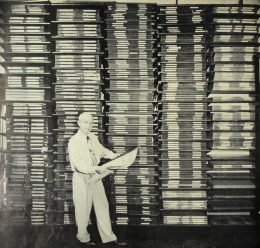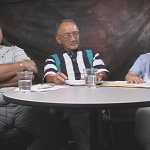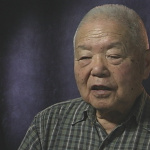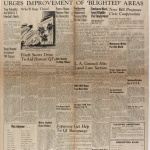Yasutaro Soga
| Name | Yasutaro Soga |
|---|---|
| Born | 1873 |
| Died | 1957 |
| Birth Location | Tokyo, Japan |
| Generational Identifier |
Issei journalist and activist in Hawai'i. Arriving in the islands in 1896, he observed and/or participated in many of the key episodes of the history of post-annexation Hawai'i over a nearly sixty-year period, many of them as editor and publisher of the Nippu Jiji newspaper, which he founded. He was arrested on the evening of December 7, 1941, and, like many prewar leaders of the Issei community in Hawai'i, spent nearly four years behind the barbed wire of detention camps in Hawai'i and in the continental U.S. before returning to Hawai'i for the final decades of his life. He published a first person book length account of his incarceration in 1948, which was published in English translation in 2008.
Before the War
Yasutaro Soga (1873–1957) was born and raised in Tokyo and enjoyed a relatively privileged childhood that effectively ended with the death of his mother when he was fifteen and of his father when he was nineteen. As a young man, he studied both law and pharmacy, but did not finish either degree. He went on to study English, and moved to Yokohama where he worked in retailing and exporting.
In 1896, he was invited to go to Hawai'i by a close family friend to help with that family's business. Seeing it as an opportunity to pursue further education in America, he took the long journey. He worked at his friend's plantation store in Waianae for two years, then went on to manage branch stores in Waipahu and on Moloka'i. In 1899, he moved to Honolulu, beginning his career as a journalist with the Hawaii Shimpo . He became a recognized leader of the community in the aftermath of the 1900 Chinatown Fire, taking part in a joint Chinese-Japanese organization formed to fight for just compensation in the aftermath of the fire and later in efforts to form a Central Japanese Association throughout the islands.
Quitting the Shimpo after an ideological dispute over immigration company issues, Soga took over the rival Yamato Shimbun newspaper in 1905 and rechristened it the Nippu Jiji in November 1906. He became embroiled in what would become the great 1909 plantation strike when his paper took up the cause of higher wages for Japanese plantation workers. Serving as a leader of this first territory wide plantation strike, he eventually ended up imprisoned for conspiracy with three compatriots (one of whom was his future arch-rival, Kinzaburo Makino) and exited prison to a hero's welcome within the Japanese community. While he was imprisoned, his wife, Kozue Sugino, took ill and returned to Japan for care, where she died shortly after his release.
Over the next three decades Soga, would lead the Nippu Jiji to become one of Hawai'i's leading newspapers, with a readership that began to reach beyond the Japanese community with the institution of an English section in 1919. Soga also become a recognized leader of the community, playing a role in nearly all of the key issues facing the community prior to World War II, including the Japanese language school regulation issue (he led a faction opposing the litigation challenging the constitutionality of laws regulating language schools), citizenship for Issei (he was a supporter of the Ozawa v. U.S. case), relations between Japan and the U.S., and the future of the Nisei generation as a board member of the New Americans Conferences. After remarrying (to Sei Tanizawa, the daughter of a lawyer and politician from Shiga Prefecture), he made several return trips to Japan; after his fourth trip in 1934 during which he visited Manchuria, he wrote the book Nichiman o Nozoku ( A Glimpse into Japan and Manchuria ). He also gained acclaim as a tanka poet, writing under the pen name Keiho. He and his wife were active members of the Makiki Christian Church, led by his friend and ally Takie Okumura.
Wartime Detention
As with many other Issei community leaders, he was arrested after the attack on Pearl Harbor on December 7, 1941, and embarked on a four-year odyssey to various American concentration camps. The sixty-eight year old Soga was held for the first few nights at the Immigration Station building in Honolulu, then was moved to the Sand Island camp where he was held for several months. Going to the mainland in August of 1942, he spent about a month at Fort McDowell/Angel Island in San Francisco Bay before spending the rest of the war in U.S. Army or Justice Department administered camps in New Mexico, Lordsburg (September 1942 to June 1943) and Santa Fe (June 1943 to October 1945) before returning to Hawai'i in November 1945. He published a detailed memoir of his time in detention in a series of newspaper articles that became a book titled Tessaku Seikatsu (Life behind Barbed Wire) published in Hawai'i in 1948.
Aftermath
Upon his return to Hawai'i, he resumed writing editorials and columns for the Hawaii Times (the new name taken on by the Nippu Jiji during the war) and also resumed writing poetry. He became a naturalized citizen in 1952 after the passage of the Immigration Act of 1952 , and in 1953, he published his autobiography, Gojunen no Hawaii Kaiko (Fifty Years of Hawaii Memories). He died on March 7, 1957, at the age of eighty-three.
For More Information
Monobe, Hiromi. "Shaping an Ethnic Leadership: Takie Okumura and the 'Americanization' of the Nisei in Hawai'i, 1919–1945." Doctoral dissertation, University of Hawai'i, 2004.
Nakano, Jiro, and Kay Nakano, ed. and trans. Poets Behind Barbed Wire . Honolulu: Bamboo Ridge Press, 1983.
Soga, Yasutaro [Keiho]. Life behind Barbed Wire: The World War II Internment Memoirs of a Hawai'i Issei . Translated by Kihei Hirai. Introduction by Tetsuden Kashima. Honolulu: University of Hawai'i Press, 2008.
Last updated Aug. 24, 2020, 2:36 p.m..

 Media
Media







